|
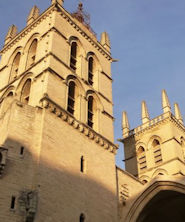 Dwight Peck's personal website Dwight Peck's personal website
Ten wintry days in the South of France
Montpellier, Arles, the Camargue, and lots of et cetera
You may not find this terribly rewarding unless you're included here, so this is a good time for casual and random browsers to turn back before they get too caught up in the sweep and majesty of the proceedings and can't let go.
Settled into Teyran, scoping out Montpellier

We're expected at the beautiful Maison Isabelle chambre d'hôtes in tiny Teyran, perfectly poised 12 km northeast of downtown Montpellier for our sightseeing agenda.

"Expected" might be too strong a word, but with persistence we got in.

Here we are, in the basement or cave -- the room's not been made up yet, so we'll just leave the luggage, if we can find room for it, and go to Montpellier, why not?

Our room's got charme, all right, though it's, well, really tiny -- it's not the pick of the litter, but our hosts have family coming in for the holidays, so the upstairs rooms will be occupado.

A certain shrine-like quality. Recalling our close call with starvation in Calvi, Corsica, on Boxing Day 2009, with only bar snacks available in the city, in Teyran we'd booked the 'dinner option', a sit-down dinner with our hosts though not the same menu; very nice people, alternating amiably between broken English/broken French, but not the option I'd recommend.

Our shower. Very cute. But don't turn around too fast.

Kristin in Teyran (not Tehran)

The Maison Isabelle
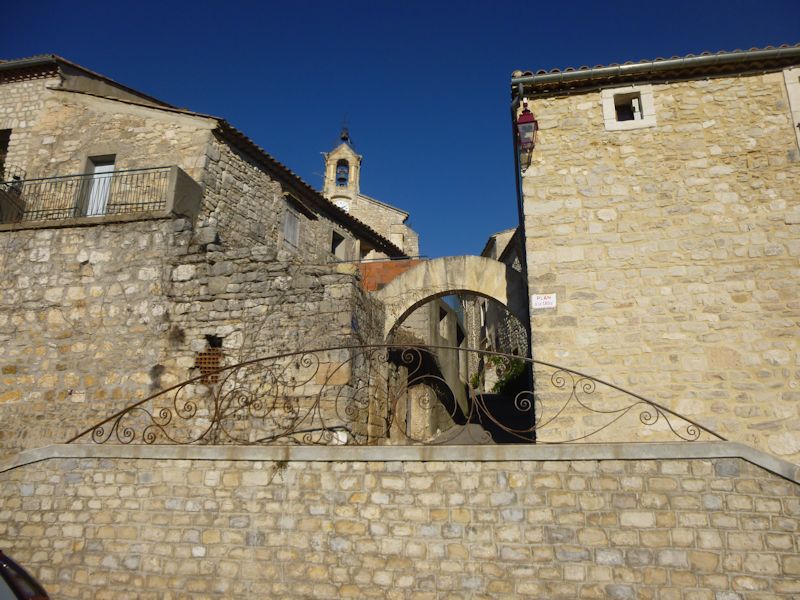
We're off for a quick walk around town (it didn't take long). Teyran, in the Languedoc-Roussillon region, has got about 4,500 inhabitants most or all of whom love their village very much. But really. It's got a SPAR market, a tennis club, a Brasserie des Poetes that was closed for the Christmas season, an excellent restaurant Le Midi-Teyranais that was open only on Saturday night, and a take-out pizza stand where we had to dine in, with a pizza chef who was filling in for his friend.

The parish church of Sainte Marie du Salaison

The mairie or town hall of Teyran

The Paroisse Ste Marie du Salaison

Homey. The focus of the service must be on the Lesson for the Day; there's not much else to occupy the eye.

Teyran street scenes

And now for a Montpellier reconnaissance . . .
Montpellier

The Arc de Triomphe of the Porte du Peyrou, round the west side of the city, viewed whilst in a blind fury from our first experience with the Volvo GPS Navigator device built into our new (used) tiny Volvo, Sven. The machine knows all the streets but has no concept of one-way traffic, which in French cities results in potentially infinite circles.
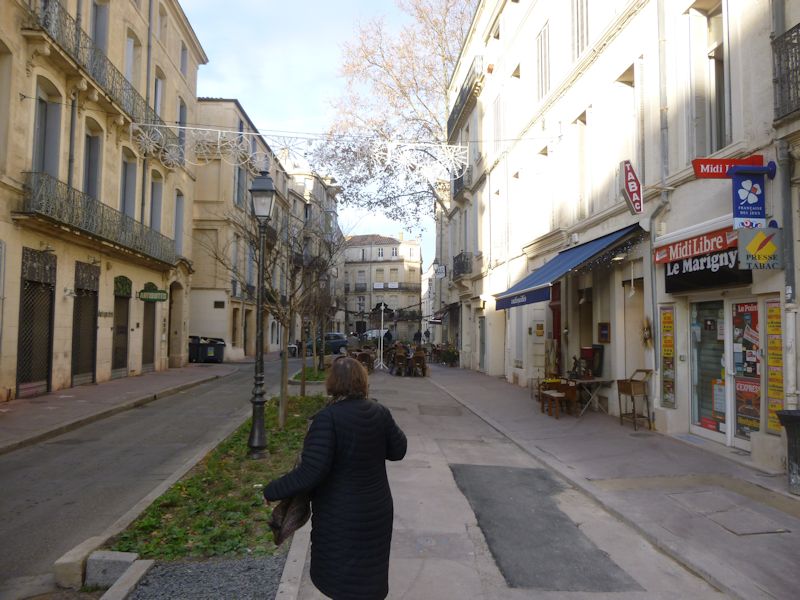
Metropolitan Montpellier is a huge agglomeration of more than half a million, with a quarter million in the centre city; the 8th largest city in France, and its fastest growing city over many years. It's one of the few substantial French cities that's got no Roman remains; it was Maguelone (presently Villeneuve-lès-Maguelone), 10km closer to the coast, that was one of the seven cities of 'Septimania' (others included Agde, Béziers, and Nîmes, all of which we'll be visiting in due course) of the Roman Narbonensis province and passed to the Visigothic kingdom in 462. Then to the Spanish Moors, then to Charles Martel's Franks.

Maguelon's coastal vulnerability to Saracen pirates, however, convinced a lot of sensible people that they needed to review their options, and they settled a bit farther inland on the two hills on the river Lez, and the rest is history. The city is attested from 985, protected by the walls and castle of the feudal Guilhem ('William') dynasty. There was an unbroken succession of Lords William of Montpellier through to William VIII in 1202, when his daughter Marie married (several people, and then) Peter II, King of Aragon, in 1204, and the city became part of the kingdoms of Aragon and then Majorca into the 14th century. There is still a significant Spanish-heritage population in the town, as well as a lot of pied noir French who left Algeria after its independence.

Under William VIII, by the way, Montpellier was famous for its patronage of the troubadour movement of poets and for its environment of toleration for Jews, Moors, and Cathars, with innovative university faculties of medicine and law at about the same time. Under the Aragonese, now with its charter of freedoms in hand, the city became an important trading centre, especially for the spice trade, and is said to have become the second or third most important city in France at the time (though it's not clear what 'France' would have comprised at that time). There was a population of as many as 40,000 souls prior to the Black Death of 1348.

The city's stock may have tanked after the Black Death, because its then-owner, the desperate King James III 'the Unfortunate' of Majorca, sold the place to Philip VI of France in 1349 -- and that's how Montpellier became French. Not that that helped much in 1622, when the city, by then a stronghold of the Protestant Huguenots, was besieged and taken over by Louis XIII, who then built the Citadel fortress to keep a close eye on folks. The Citadel fortress has been remodeled as a high school since 1947.

Here, in the neighborhood of Sainte-Anne, is the Church of Saint Anne, one of the tallest landmarks in the city, but not a church.

An attractive, almost-convincing Neo-Gothic construction from the 1860s, it's been decommissioned and now hosts exhibitions of modern art and what not. And not open now.

We'd really like to visit the St Peter's Cathedral first off, but we haven't got a city map yet.

But we'll see the belltower, surely. Not this way.

The Porte du Peyrou, in the centre and high point of the city, is an imposing but basically kind of silly self-glorification of the French king Louis XIV, the Sun King. It was completed in 1693, and the reliefs, added in 1715, celebrate some of the major accomplishments of his reign: the victory over and annexation of Namur in 1692 (it was taken back by the Dutch 3 years later); the building of the Canal du Midi (1667-1682) between the Bay of Biscay and the Mediterranean (which was Minister J-B Colbert's project, engineered by P-P Riquet); the revocation in 1685 of the religious toleration Edict of Nantes (1598) because the king couldn't stomach the idea that anyone should be worshipping in any way other than his own; and Louis dressed as the heroic man-god Hercules. Quite an impressive record.

We're in the Place Royale du Peyrou, still looking for a Cathedral (any Cathedral!). That's the Arc de Triomph and the church of Ste-Anne we saw earlier.

No sign of a Cathedral over that way. That's part of the Palais de Justice that fronts on the other side of the Peyrou Gate.

The pièce de resistance of the Jardin du Peyrou. I wonder who that chubby fellow might be: ah, it's Ludovico Magno (Louis XIV). Quel surprise.

Wait. What's that? Could it be?

Now how to get there

A commemorative statue to unicorns (actually it commemorates the French victory over the British and Germans at Clostercamp [Kloster Kampen] near Wesel on the Rhine in October 1760, in the Seven Years' War) - (the connection with unicorns is not obvious).
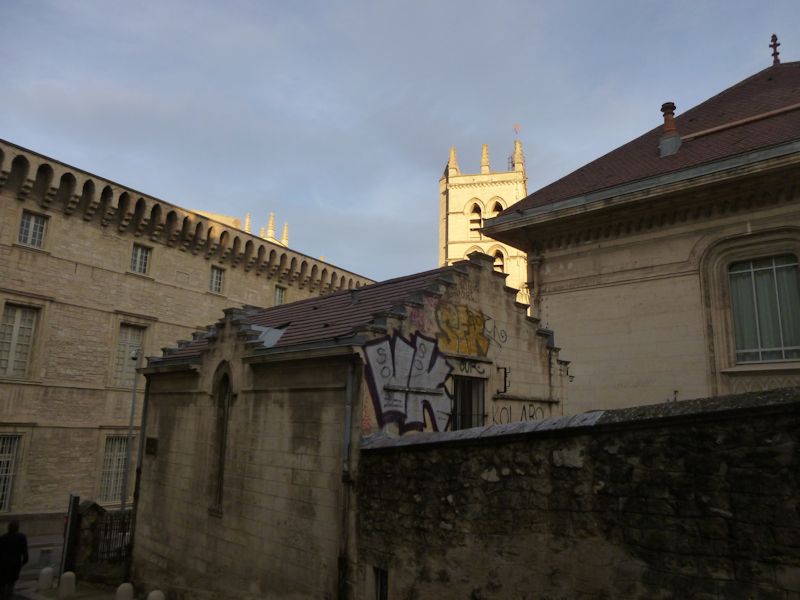
There it is -- if that's not a Cathedral, I'll . . . .

At last, the Cathédrale Saint-Pierre de Montpellier, with its twin rocket ships out front

Shall we?

Late afternoon sunlight enhances everything, if you're facing the right way.
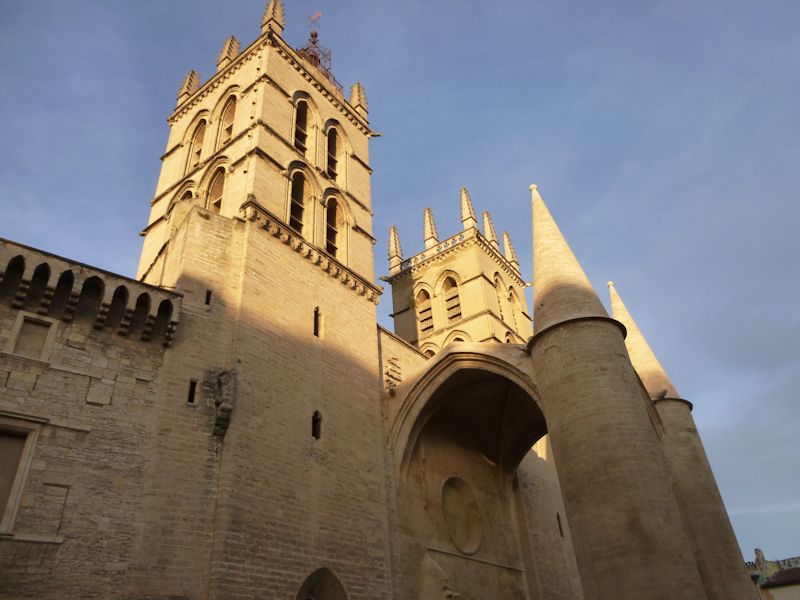
I have no idea what the rocket ships are for -- maybe helping to keep the belltowers upright.

The first cathedral church served as the chapel of the Monastery-College of St-Benoît St-Germain, consecrated in 1367. The episcopal seat was transferred here from Maguelone in 1536.

Alas, however, the Protestants, during the French Wars of Religion, destroyed the Cathedral as well as lots of Catholics besieged inside during the years 1561 to 1567. The present replacement building dates from the early 17th century and, despite being treated very badly during the French Revolution (and converted to use as military stables), survives mostly as it was then with some additional chapels added in the mid-19th century.

The old Cathedral had four similar towers, very rare, but one of them got knocked down in 1567.

Here we go

A baptismal font with fun figures on it

The nave

The altar

The vaulted apse

The other side of the baptismal font

-- This way, children.

A last look

The VIP entrance

Kristin dwarfed


We still haven't got a city map, so anybody's guess is as good as ours.

A little park, probably the one between the Rue du Four Saint-Éloi and the Rue de Candolle, just east of the Cathedral

A public park, it might be said. With children passing by.
      
    
 Feedback
and suggestions are welcome if positive, resented if negative, Feedback
and suggestions are welcome if positive, resented if negative,  .
All rights reserved, all wrongs avenged. Posted 27 January 2015. .
All rights reserved, all wrongs avenged. Posted 27 January 2015.
|
 Dwight Peck's personal website
Dwight Peck's personal website






















































